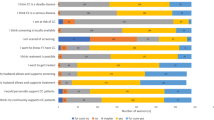Abstract
Malawi has the highest incidence of cervical cancer in the world. Due to various challenges the country faces in terms of cervical cancer control, women have a poor chance to survive this disease. The purpose of our study was to describe the knowledge and practices of cervical cancer and its screening as well as the educational preferences of women living in a rural community in the Chiradzulu District. We conducted a survey among women between the ages 30 and 45, used convenience sampling, a calculated sample size (n = 282) and structured interviews to collect the data. A questionnaire adapted from a previous study served as data collection instrument. The data were analysed in Microsoft Excel and chi-square (p < .05) was used to investigate the relationships between the variables. Content analyses analysed the open-ended questions. The mean age of the sample was 36.1 (SD ± 5.1) and the highest percentage (37.4%; n = 98) belonged to the Yao ethnic group. The majority attended primary school (66.0%; n = 173), were married (74.4%; n = 195) and depended on a small business as source of income (55.7%; n = 146). Most of the women (93.4%; n = 247) had heard of cervical cancer and the visual inspection with acetic acid (VIA) screening programme (67.9%; n = 178) but only 22.9% (n = 60) indicated they had been screened. Lack of knowledge of the screening programme was the most common reason for not being screened. Having a demonstration of the VIA procedure was the most popular educational method (92.0%; n = 241) which gives a fresh approach to educational programmes aimed at preventing cervical cancer.
Similar content being viewed by others
References
World Health Organization (2015) Cervical cancer: estimated incidence, mortality and prevalence worldwide in 2012. http://globocan.iarc.fr/old/FactSheets/cancers/cervix-new.asp. Accessed 31 July 2018
Msyamboza KP, Dzamalala C, Mdokwe C, Kamiza S, Lemerani M, Dzowela T, Kathyola D (2012) Burden of cancer in Malawi; common types, incidence and trends: national population-based cancer registry. BMC Res Notes 5(1):149
Aaronson NK, Ahmedzai S, Bergman B, Bullinger M, Cull A, Duez NJ et al (1993) The European Organization for Research and Treatment of Cancer QLQ-C30: a quality-of-life instrument for use in international clinical trials in oncology. JNCI 85:365–376
Anorlu RI (2008) Cervical cancer: the sub-Saharan African perspective. Reprod Health Matters 16:41–49
Palacio-Mejía LS, Rangel-Gómez G, Hernández-Avila M, Lazcano-Ponce E (2003) Cervical cancer, a disease of poverty: mortality differences between urban and rural areas in Mexico. Salud Pública Mex 45:315–325
Rudd P, Gorman D, Meja S, Mtonga P, Jere Y, Chidothe I, Msusa AT, Bates MJ, Brown E, Masamba L (2017) Cervical cancer in southern Malawi: a prospective analysis of presentation, management, and outcomes. Malawi Med J 29(2):124–129
World Health Organization (2006) Comprehensive cervical cancer control: a guide to essential practice. World Health Organization, Geneva
Maseko FC, Chirwa ML, Muula AS (2014) Client satisfaction with cervical cancer screening in Malawi. BMC Health Serv Res 14:420
Alliance for Cervical Cancer Prevention (2004) Planning and implementing cervical cancer prevention and control programs: a manual for managers. Alliance for Cervical Cancer Prevention, Seattle
Malawi Ministry of Health (2005) National service delivery guidelines for cervical cancer prevention. https://www.k4health.org/toolkits/malawi-hivaids/national-service-delivery-guidelines-cervical-cancer-prevention. Accessed 1 August 2018
Hami MY, Ehlers VJ, Van der Wal DM (2014) Women’s perceived susceptibility to and utilisation of cervical cancer screening services in Malawi. Health SA Gesondheid 19(1)
ICO/IARC Information Centre on HPV and Cancer (2017) Malawi. Human papillomavirus and related cancers, fact sheet 2017. http://www.hpvcentre.net/statistics/reports/MWI_FS.pdf. Accessed 2 August 2018
Kayange P (2005) Fighting against cervical cancer: the case of Malawi. Malawi Med J 17(2):43–44
Kumbani LC, Chirwa E, Malata A, Odland JØ, Bjune G (2012) Do Malawian women critically assess the quality of care? A qualitative study on women’s perceptions of perinatal care at a district hospital in Malawi. Reprod Health 9(30)
Kamanga P, Vedeld P, Sjaastad E (2009) Forest incomes and rural livelihoods in Chiradzulu District, Malawi. Ecol Econ 68:613–624
Ports KA, Reddy DM, Rameshbabu A (2015) Cervical cancer prevention in Malawi: a qualitative study of women’s perspectives. J Health Commun 20:97–104
National Statistical Office (NSO) and ICF Macro (2011) Malawi Demographic and Health Survey 2010. NSO and ICF Macro, Maryland
Grove SK, Burns N, Gray J (2014) Understanding nursing research: building an evidence-based practice. Elsevier Health Sciences, Philadelphia
Rwamugira J, Maree JE, Mafutha N (2017) The knowledge of South African men relating to cervical cancer and cervical cancer screening. J Cancer Educ 1–7. https://doi.org/10.1007/s13187-017-1278-4
United Nations (2014) Malawi Country Profile. http://www.mw.one.un.org/country-profile/. Accessed 31 July 2018
World Bank (2018) The World Bank in Malawi. http://www.worldbank.org/en/country/malawi/overview. Accessed 2 August 2018
Rosser JI, Zakaras JM, Hamisi S, Huchko MJ (2014) Men’s knowledge and attitudes about cervical cancer screening in Kenya. BMC Womens Health 14:138
Mokhele I, Evans D, Schnippel K, Swarts A, Smith J, Firnhaber C (2016) Awareness, perceived risk and practices related to cervical cancer and pap smear screening: a crosssectional study among HIV-positive women attending an urban HIV clinic in Johannesburg, South Africa. SAMJ 106:1247–1253
Sheeran P, Orbell S (2000) Using implementation intentions to increase attendance for cervical cancer screening. Health Psychol 19:283–289
Getahun F, Mazengia F, Abuhay M, Birhanu Z (2013) Comprehensive knowledge about cervical cancer is low among women in Northwest Ethiopia. BMC Cancer 13:2
Maree JE, Wright SC (2010) How would early detection be possible? An enquiry into cancer related knowledge, understanding and health seeking behaviour of urban black women in Tshwane, South Africa. Eur J Oncol Nurs 14:190–196
Fort VK, Makin MS, Siegler AJ, Ault K, Rochat R (2011) Barriers to cervical cancer screening in Mulanje, Malawi: a qualitative study. Patient Prefer Adherence 5:125
Author information
Authors and Affiliations
Corresponding author
Additional information
Publisher’s Note
Springer Nature remains neutral with regard to jurisdictional claims in published maps and institutional affiliations.
Rights and permissions
About this article
Cite this article
Maree, J.E., Kampinda-Banda, M. Knowledge and Practices of Cervical Cancer and Its Prevention Among Malawian Women. J Canc Educ 35, 86–92 (2020). https://doi.org/10.1007/s13187-018-1443-4
Published:
Issue Date:
DOI: https://doi.org/10.1007/s13187-018-1443-4




